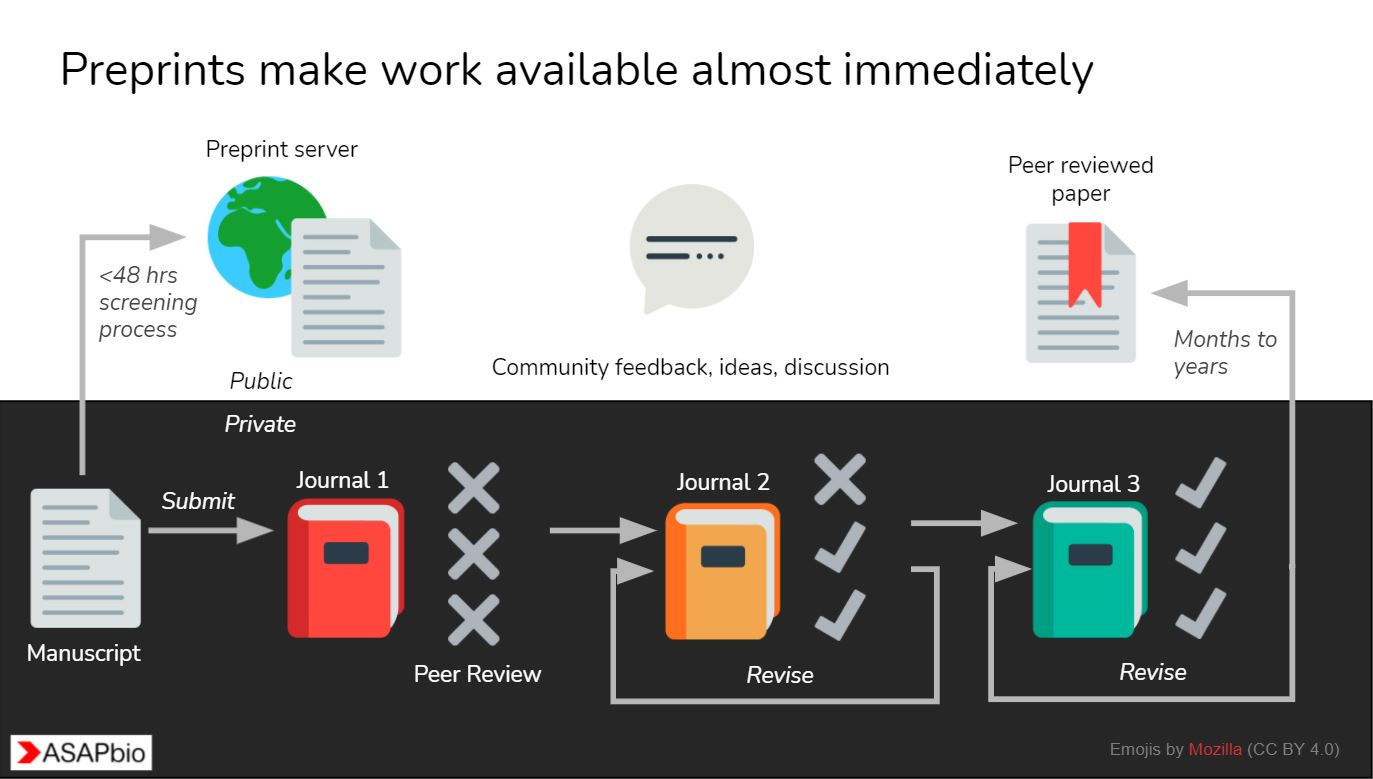Strategic publishing
What are preprints?
A preprint is essentially the final version of your manuscript, ready to be sent out for consideration by a journal publisher. It has not yet been accepted or peer reviewed.
In the traditional publishing model, this preprint is submitted to a journal and then goes through a process of review and revision before becoming available to subscribers of that journal - a process that can sometimes take years.
https://docs.google.com/presentation/d/1K4oXMTVPFOi9T-wyIZG1WXDrjfit4wQFKMZQk3i6-SY/edit#slide=id.g910196faf0_0_200
The preprint model sees your manuscript uploaded in its raw form to a repository or server where it becomes available almost immediately. Here it can attract feedback and comment from peers in your field, and from other disciplines, allowing revision and development before going to a journal publisher.
This immediacy has been particularly valuable during the COVID-19 pandemic, allowing rapid dissemination of information. However it is important to remember that preprints are NOT peer reviewed and should be read or cited with a degree of caution.
Good reasons to consider preprinting include:
- staking a priority claim on your ideas and discoveries
- increasing awareness of your research
- helping you meet new people and potential collaborators in your field
- showing proof of your productivity to funders
- providing free access to your work (note that this is not the same as Open Access given the non-reviewed status of preprints).
Watch:
- What are preprints? / ASAPbio
-
Preprints - Publishing Power Hour video
A 2021 presentation by Dr Zoe Bradfield (Curtin School of Nursing) and Professor Simon Lewis (Forensic and Analytical Chemistry) on their preprinting experiences with medRxiv and chemRxiv [01:02:04] - Preprints – a practical guide / Jessica Polka, ASAPbio. Presentation slides to accompany the recording are also available.
Preprint servers/repositories
Since the emergence of the first preprint server, arXiv, in the early 1990’s, a large number of discipline specific and general repositories have been developed.
Ask your colleagues which repositories are used in your discipline, or use the links listed below to search for preprint servers:
- ASAPbio - directory of preprint platforms relevant to life sciences, biomedical, and clinical research.
- List of preprint repositories – covers all disciplines.

Image compiled by Jeroen Bosman (@jeroenbosman) via Bianca Kramer (@MsPhelps)
Preprint FAQs
-
Will a journal accept my paper if it has been on a preprint server?
In most cases, yes. Some journals actually run their own preprint servers, others offer the option of loading your manuscript onto a preprint server at the same time as you submit it for publication (eg PLOS). However there are some journals, especially those with double blind peer review, where previously published preprints are not eligible. You can check the preprint policy of journals using the Open Policy Finder (formerly known as Sherpa Romeo). -
Do funding bodies accept preprints as evidence of my publication track record in grant applications?
In the 2021 National Competitive Grant Program grants round, the Australian Research Council excluded preprints from researchers publication track records and disqualified 32 early and mid career researchers who included preprints in their applications. This caused an uproar in the scholarly community, especially amongst physicists and astronomers who routinely share their preprint versions. This policy was quickly overturned and for future rounds the ARC “will allow the referencing and inclusion of preprints in any part of a National Competitive Grant Program (NCGP) grant application. This includes within the Research Outputs list as well as the body of an application”. Read the full ARC Open Access Policy.The NHMRC supports preprints, as do most international funding bodies. Learn more about international funder policies towards preprints on the ASAPbio FAQ page.
-
How do I choose a licence for my preprint?
Unless you have already submitted your work to a publisher or have some other funding arrangement whereby the IP in your work is owned by others, you are generally free to choose the licence under which your preprint will be published. You might choose to retain all rights or apply a Creative Commons licence. There is a lot of useful advice on this process on the ASAPbio licencing FAQ page. -
Can I promote my preprint to help others find it?
Absolutely! This is one of the great things about preprints - they are available for anyone to read, share and comment on. However if you have lodged your preprint as part of the traditional publication process - ie at the same time as submitting to a journal - you may be limited in how much you can promote your work until the final published version is available. Check your publisher guidelines. -
How do I cite a preprint?
Some preprint servers assign a DOI to preprints which makes them simple to cite - others such as ArXiv do not use DOIs but have their own persistent identification system which can be used in citation. See examples using the APA referencing style here. Check journal and funder guidelines to ensure you are citing in the style required. -
Can I upload a corrected version of my manuscript to a preprint server?
Yes. The real value of the preprint model is that it allows comment and revision of your manuscript prior to formal publication. Amendments made as a result of suggestions by others can be formulated into a new version of your work and uploaded as a new version. If necessary, your manuscript can also be withdrawn. Different preprint servers handle versioning and withdrawal in different ways. You can read more about specific policies in the ASAPbio directory of preprint servers.
For answers to more questions about preprints, check out the FAQ’s on the ASAPbio website.
